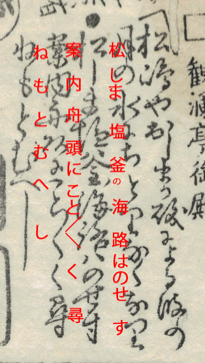Reading Japanese maps and marketing practices 5 - solution

Answer:
松しま塩釜の海路はのせす案内舟頭にこと/\く尋ねもとむへし
The map states that the reader should look for a guiding boatman (案内舟頭) and ask him for information about the surroundings (尋ねもとむべし), clearly implying that, by this time, there was already some kind of professional touristic guiding in the area. This recommendation is due also to the fact that there were some meisho only reachable by boat. This might be the case for the stone monument situated on a small island in the middle of the bay. The monument indicated on the map was erected in the 14th century in honor of a certain monk called Raiken (頼賢) and still stands today. The map also warns the traveller not to take the ferry line between Matsushima and Shiogama by mistake, whose route is indicated in black over the waters of the bay. From this kind of indications, we might infer that the map in question was devised as a portable guide, and that the reader was expected to follow its indications while traveling across the region.
